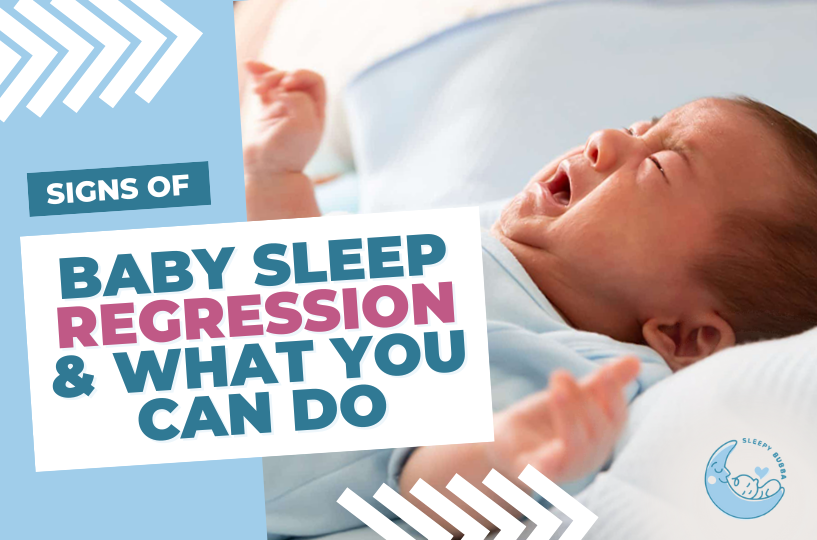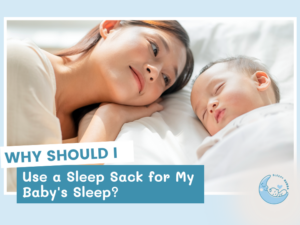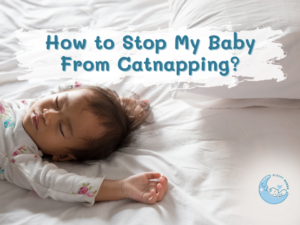Enquire Now with FREE 15 Mins Call
Signs of Baby Sleep Regression and What You Can Do

Despite how it sounds, baby sleep regression isn’t something dangerous or unusual. In fact, it is part of your baby’s growth process. Sleep regression is, very simply, changes in your baby’s sleep patterns.
Most experts agree that around the baby’s fourth month, they begin to experience changes in the way they sleep. When they are newborns, they only go through two stages of sleep. One of them is a deep, regenerative sleep whereby healing, growth, and repair of the body happens. The other one is a lighter sleep stage called REM, characterized by dreaming and it stimulates the areas of the brain that help with learning.
However, around their fourth month, this changes to four stages of sleep. In short, two more sleep stages are added to make a total of four stages, which is the sleep pattern that babies will carry on into adulthood.
These two additional stages of sleep, known as Stage 1 ( drifting off) and Stage 2 ( true sleep) are pretty light stages of sleep, and can therefore cause babies to wake up more easily than before.
Signs of Sleep Regression
Different babies respond and act differently during their sleep regression stage. This means that not all babies will develop the signs mentioned below. However, it is still important to know what these signs are and look out for them.
Frequent Night Wakes
Your baby wakes up twice or more times throughout the night and refuses to go back to bed. They might also fuss and this disrupts your own rest as well. Putting them back to sleep might also be challenging and difficult, causing many parents sleepless nights.
Refusal to Sleep at Bedtime
If your baby usually falls asleep easily during their bedtime, you may now see a change in this as they are suddenly wide awake. Their resistance to sleep can come as a surprise as they can often appear to be ‘fighting’ sleep and staying awake longer and longer. They may also be wide awake during their usual bedtimes, throwing their sleep patterns into a mess.
Skipping Nap Times
Your newborn spends much of their time sleeping and taking naps. However, when sleep regression happens, you’ll notice that they take fewer naps or have a shorter nap time. Babies tend to stay awake longer when they’re going through sleep pattern changes. Therefore, if you see them skipping a nap that they usually take, this can point to sleep regression.
Increased Fussiness
Babies who are undergoing sleep regression tend to be more irritable. This is because they are trying to adapt to the growth processes in their bodies. Although this period can be challenging for parents, it is also uncomfortable for the babies as they’re still too young to have any control or understanding of the situation.
Difficulty Going Back to Sleep
As mentioned earlier, babies facing sleep regression wake up several times throughout the night. The process of going back to sleep can take longer than usual, and they will appear to be wide awake for a longer period of time too. In many cases, they will get less sleep, or their sleep quality may be less than before their sleep regression started.
What Can I Do As A Parent?
Of course, seeing your child undergoing such changes can be concerning. At times, it can be heartbreaking too. That’s why it is important to remember that this period of change is very common and it is temporary.
To help your child adapt better, you can consider the following steps:
Create a Sleep-Conducive Bedroom

Having a bedroom that encourages sleep should be one of your first steps. Make sure your baby’s room is as quiet as possible. Keep it dark with blackout curtains that can be drawn across the window and keep out light. Keeping the room dark and quiet minimizes the amount of stimulation your baby receives and will minimize disruptions to their sleep.
Consider a White Noise Machine
White noise machines or just playing white noise for babies have been shown to help them sleep. Very simply, white noise is the noise you hear when you leave the television on but nothing is being broadcasted.
Alternatively, there are also white noise machines that play the soothing sounds of nature, or flowing water. These soothing noises are able to calm your baby. However, experts suggest that white noise machines should be placed at least 2 meters away from your baby’s cot and the sound level should not be too loud.
Keep a Bedtime Schedule
Having a bedtime schedule doesn’t just mean having a fixed sleeping and waking time. It also means having a bedtime routine. For example, some parents like to give their babies a massage before bedtime, or rub some baby lotion. Others like to give their babies a goodnight cuddle, sing them a lullaby or give them a bath and change them into fresh pajamas.
These types of actions train your baby’s subconscious mind to register that it is time for bed, and will help them wind down more easily.
Keep the Room Cool
Bedroom temperatures have been shown to affect a baby’s sleep too. This is why experts suggest that you turn on the air-conditioner in your baby’s room and put them in a warm onesie with a blanket. The cool air is able to encourage your baby to calm down and relax more easily.
Of course, you’ll have to ensure that your baby likes this arrangement and the cooler temperature. It’s worth a shot if your home is equipped with an air conditioning unit.
Consider a Professional Sleep Consultant
If you’ve tried to help your baby on your own, but aren’t satisfied with the results, you can always hire a sleep consultant. These are trained sleep therapists with scientific training who are able to recommend ways catered specifically to your child’s needs.
When it comes to sleep training baby in Singapore, parents are actually fortunate to have options. There are several baby sleep Singapore experts that can help, including Sleepy Bubba. Come speak to us about our baby sleep consultant price that suits your budget.







